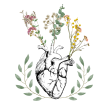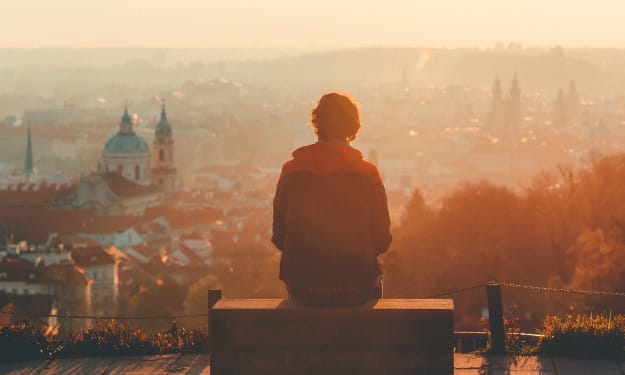How Becoming an Artist Changed My Relationship to My Body
Seeing myself from a fresh perspective was a revelation

Unknowingly Embarking on a Journey
I’ve been focusing on visual art casually since 2018, and more seriously since the start of the pandemic in 2020. While I sporadically sketched and played around with digital painting and some student-grade acrylic those first two years, I think the greatest contribution to my artistic growth in 2018 and 2019 came in the guise of unlearning some really toxic beliefs and assumptions about art.
First, there were all those beliefs that devalued, wholesale, the work of entire genres of artist: the idea that digital art was somehow lesser than traditional art; the idea that realism was the only valid stylistic aspiration for burgeoning artists; or the idea that art had to be “serious.”
I spent nearly two years discovering fellow artists who did equally amazing things with both a tablet and a paintbrush; who created art in various styles; and who created art to do such disparate things as process trauma and celebrate their favorite TV shows.
Next was unlearning harmful or false beliefs about the practice of art — like the misconception that you absolutely have to draw every day in order to hone your skills as an artist. Or that you needed the most high-end supplies to create adequate art. Or that so-called “good” artists don’t use reference photos.
It was that last one, honestly, that threw me.
It seems like a no-brainer in hindsight, but in my teenage days, dabbling in DeviantArt, “drawn from reference” was considered to be the quintessential mark of the amateur, and those formative experiences are insidious and hard to shake.
But no — professional artists do, in fact, draw from reference. Often times, many, many references — Frankenstein-ing together bits and pieces from various sources to create new, fully-fledged compositions.
This was a game-changer. I immediately set out to discover, and become well-acquainted with, the world of stock photos, including the thriving subset of people — generally artists of a sort themselves — making their own stock specifically for use as drawing reference.
It was in my discovery of the world of art modeling that I unknowingly began the process of changing the way I saw and thought about my own body.
A History of Body Baggage
I’ve always been “big.” I started puberty at eight-and-a-half, had a regular menstrual period by nine, and by ten, was nearly five-foot-four, and wearing a B-cup. “Fat” would come soon after, when puberty fully caught up to me to grace me with significant hips, stretch marks, and tummy rolls. “Fat” became one of my defining features throughout most of my life, which, to paraphrase poet Blythe Baird, didn’t bother me until I found out it was supposed to.
The sneaky thing about self-hatred, especially around appearance, is how compartmentalized your beliefs become. In my late teens and early 20s, I was (and continue to be) a pretty vocal feminist and body-positive activist, despite the complicated feelings I had internalized about my own body. All my body-positive mantras came with asterisks or parentheticals: Every Body is a Good Body (except mine). Fat is Beautiful (except for me).
Maybe it’s because I spent my formative years being told I was unattractive, or lazy, or because as a child I would routinely receive age-inappropriate comments on my body from people who assumed I was significantly older than I was, but I could not manage to integrate my own self-image into the philosophy I so rigorously held for literally everyone else.
It wasn’t something I consciously thought about or something I dissected until much, much later in life; it was simply static, playing in the background of my mind; something at the periphery of my awareness, but rarely the focus.
By the time I embarked on my art journey, my body had undergone countless changes and transformations, not the least of which was giving birth, and my relationship with it was, as always, fraught — but also something I was finally starting to consciously inspect and challenge.
I became aware at some point, as I was drawing more and more figures, that the majority of the bodies I drew were thin. In fact, at that point, all of the bodies I drew were thin.
This was at least in part due to most of the more popular photo reference sites greatly favoring thin, conventionally attractive models — there were some, certainly, who made a conscious effort to include variation in body type, but because these were generally passion projects, most of the purveyors of these stocks were either solo models, or limited by who was in in their social circle or who was in a reasonable travel-radius and willing to contribute. For whatever the reason, while not non-existent, stock sites certainly didn’t favor larger bodies.
Inevitably, someone would eventually come along to fill the niche.
In the summer of 2020, I was actively scouring social media for queer and fat-positive art spaces. I was just beginning to build momentum with my art practice during the height of the pandemic and wanted to be more proactive in diversifying my repertoire and finding a niche among other artists. It was early August when I stumbled upon a call for submissions for a fat photo reference gallery.
The site was a just-getting-started stock photo compendium, crowd-sourced from dozens of fat volunteers, most of the artists themselves, who were looking for more size diversity and celebration of fat bodies in art. I was immediately intrigued and started paging through submissions right away.
There was a wide variety of body types on display, all across the fatness spectrum, and I was thrilled to see, among them, bodies like mine, with similar traits — visible scarring, stretch marks, rolls. I spent several days sketching from the archive, happy to finally find body diversity, but quickly realizing that, as the archive was still quite small, there wasn’t a huge selection of poses.
It was then I thought, wait. I’m fat. And I know the poses I want to see — I could submit some photos to the archive.
It was my own idea, but it took a little convincing; my wife spent a few days cajoling me, tempting me with her semi-professional photography equipment, assuring me that she could stage and take the photos for me and that she’d ensure the quality of each one.
Eventually, I acquiesced. I came up with a list of poses I wanted to contribute, put on some neutral-colored underwear and my flesh-toned binder, and we took, in the end, about thirty photos I was proud of.
They were uploaded the following week, and a week after that, someone posted art drawn from one of my reference photos.
Another one followed. And another.
My phone pinged every time it happened; I had credited myself under my (now outdated) Twitter handle, and each time I was tagged, a notification popped up on my phone. I remember opening those notifications and staring at them for a good long time.
Those drawings were distinctly me. I recognized my poses, my hairstyle (very distinctive!), and my body.
But I looked… good.
Fuck, I looked powerful.
The Power of Perspective
There was something powerful in decontextualizing my body from the baggage that other people had piled upon it over the years. My body was lazy, was unattractive, was a green light for sexual commentary and ridicule.
But this body, Christ. That proud, straight back, those bracing hips. Thighs that could snap your fucking neck. Divorced from others’ derision and judgments, I looked at my body and I saw power. I saw ferocity, I saw someone you didn’t want to fuck around with, lest you be unfortunate enough to find out.
But I also saw softness. I took several photos with my child (face fully pixelated), seated on the curve of my hip, and I saw a body that brought life into the world. I saw a body that nursed a child for a year and a half. I saw the dimples my child’s fingers made in the pillow of my stomach and thought about how much he loved to rest his head there. I saw, despite my old binder’s best efforts, the fullness of the breasts that my wife so loved and envied in equal measure.
I saw… beauty, I guess.
Taking a step back and viewing my body as a body instead of as a judgment, or a burden, and I was able to see utility, and strength, and capability.
And such beautiful shapes, from an art perspective. So many glorious, looping arches, so many nested folds and undulating lines, and soft-edged, satisfying, swooping curves. The first time I traced along the swell of my belly while inking a piece I had modeled for, I had to literally pause and revel in how good it both looked and felt — such a beautifully smooth, singular motion, that glorious bulge of my belly. It was wonderful.
I still use other references, of course. There are so many talented photo reference models who have props and equipment that allow them to get some amazing shots that would be impossible flying solo. But for simpler, quieter poses, I use myself all the time. I’ve come to revel in taking my own reference shots for my work; it makes me feel self-sufficient.
And drawing from those references makes me feel powerful.
If you are an artist, please, utilize your greatest resource — your own body. You are your own self-sustaining work of art; treat yourself as such.
About the Creator
Jess C.
40-something creative -- artist, writer, maker -- parent, and educator. Queer neurodivergent feminist geek. Over-worked, under-slept, over-caffeinated, and over-thinking.
---
Enjoyed the story? Support the Creator.
Subscribe for free to receive all their stories in your feed. You could also pledge your support or give them a one-off tip, letting them know you appreciate their work.






Comments
There are no comments for this story
Be the first to respond and start the conversation.